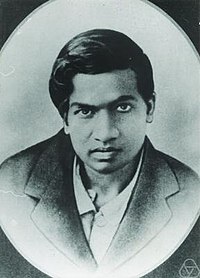
In mathematics, the nth taxicab number, typically denoted Ta(n) or Taxicab(n), is defined as the smallest integer that can be expressed as a sum of two positive integer cubes in n distinct ways.[1] The most famous taxicab number is 1729 = Ta(2) = 13 + 123 = 93 + 103, also known as the Hardy-Ramanujan number.[2][3]
The name is derived from a conversation ca. 1919 involving mathematicians G. H. Hardy and Srinivasa Ramanujan. As told by Hardy:
I remember once going to see him [Ramanujan] when he was lying ill at Putney. I had ridden in taxi-cab No. 1729, and remarked that the number seemed to be rather a dull one, and that I hoped it was not an unfavourable omen. "No," he replied, "it is a very interesting number; it is the smallest number expressible as the sum of two cubes in two different ways."[4][5]
- ^ "Taxicab Number". Wolfram Mathworld.
- ^ "Hardy-Ramanujan Number". Wolfram Mathworld.
- ^ Grime, James; Bowley, Roger. Haran, Brady (ed.). 1729: Taxi Cab Number or Hardy-Ramanujan Number. Numberphile.
- ^ Quotations by G. H. Hardy, MacTutor History of Mathematics Archived 2012-07-16 at the Wayback Machine
- ^ Silverman, Joseph H. (1993). "Taxicabs and sums of two cubes". Amer. Math. Monthly. 100 (4): 331–340. doi:10.2307/2324954. JSTOR 2324954.